The Skillful Craftsmen in Lingnan · The Guardians of Ancient Buildings | Beautiful Frescoes from the Artist’s Skillful Painting Techniques and Deep Knowledge Reserve
原本沉闷的清水砖墙面,经匠人妙笔,很快充满了诗情画意。
The originally dull fair-faced wall surface has been full of poetic and pictorial splendor soon through the artisan’s wonderful brush.
广东是古壁画大省。据第三次全国文物普查结果显示,广州地区留存有古建筑2219座,文物专家估计,散落在这些古建筑中能辨析的壁画有上万幅。如果加上岭南其他地区的壁画,数量将更可观。
Guangdong is a province full of ancient frescoes. There are 2,219 ancient buildings preserved in Guangzhou area according to the third national archaeological census. Tens of thousands of identifiable frescoes are scattered throughout those ancient buildings based on the estimation by cultural relic experts. If we take frescoes from other areas in Lingnan into account, the total number will be even more considerable.
“通过广府壁画可以看出当时哪些诗词歌赋妇孺皆知,什么样的国学故事流传最广。”在广东省文物保护专家委员会委员、广府壁画研究专家黄利平看来,壁画犹如一本“会说话的民间史书”。
“We can figure out which traditional literary works were well known and which stories on Chinese culture were most widely communicated based on the frescoes in the then Guangzhou Prefecture.” Huang Liping, a member of the Expert Committee for Cultural Relics Protection in Guangdong Province and expert on frescoes in the then Guangzhou Prefecture, regards those frescoes as “a folk history book that can talk”.
今天,让我们打开这本“书”,了解岭南建筑壁画的精妙技法,进入古时文人画匠、民间百姓的精神世界。
Today, let’s open this “book” to comprehend the exquisite techniques of architectural frescoes in Lingnan and enter the spiritual world of ancient literati, artisan-painters and ordinary people.
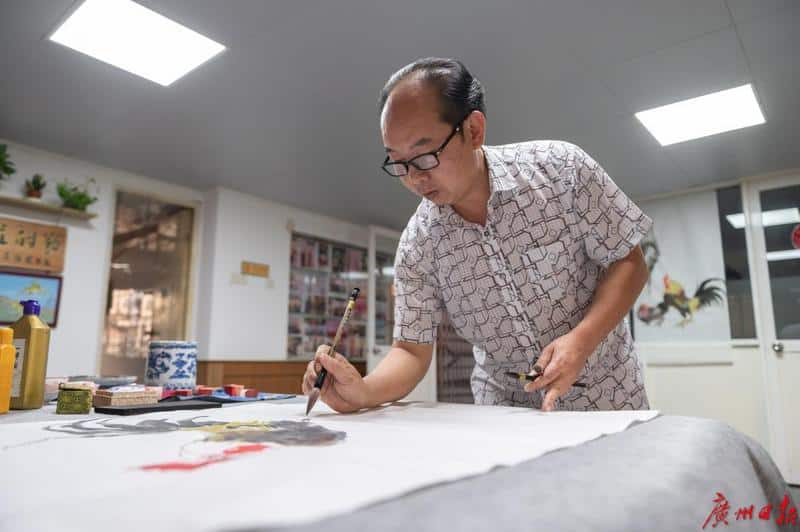
在越秀区西门口附近的一间非遗工作室里,刚从汕头市潮南返回广州参加拜师传承仪式的壁画匠人吴义廷这样解释壁画:“壁画,就是在墙壁上作画。”
In an intangible cultural heritage studio near Ximenkou of Yuexiu District, Wu Yiting, a fresco artisan who has just returned to Guangzhou from Chaonan of Shantou to attend the master-apprentice rite for craftsmanship inheritance, interprets frescoes in this way, “Frescoes are paintings on the wall.”
显然不止于此。
However, its essence is clearly more than that.
吴义廷生于壁画世家,从小学艺,在壁画领域耕耘了数十载,如今他是广东省非物质文化遗产胪溪壁画项目代表性传承人、广东省首届传统建筑名匠。
Born in a fresco family, Mr. Wu has learned this art from since childhood and then worked in the field of frescoes for decades. By now, he has become a representative inheritor of Luxi Fresco Project, an intangible cultural heritage in Guangdong Province, and one of the first batch of Traditional Architectural Artisans.
谈及壁画技法时,吴义廷提到墙壁。绘制前,一般需在砖墙上批一层底灰,等干后再在墙体上批上一层贝灰,批好后再刷上过滤好的贝灰水,等于在墙上涂上一层薄的灰浆,之后再开始作画。
When it comes to fresco techniques, Mr. Wu mentioned walls. Before drawing, an artisan should generally plaster a layer of bottom mortar on the brick wall, and then a layer of shell lime after the bottom mortar has dried. After the second plaster, the artisan should brush the filtered shell lime water, which is equal to another layer of thin plaster on the wall. Then, he can begin to paint.
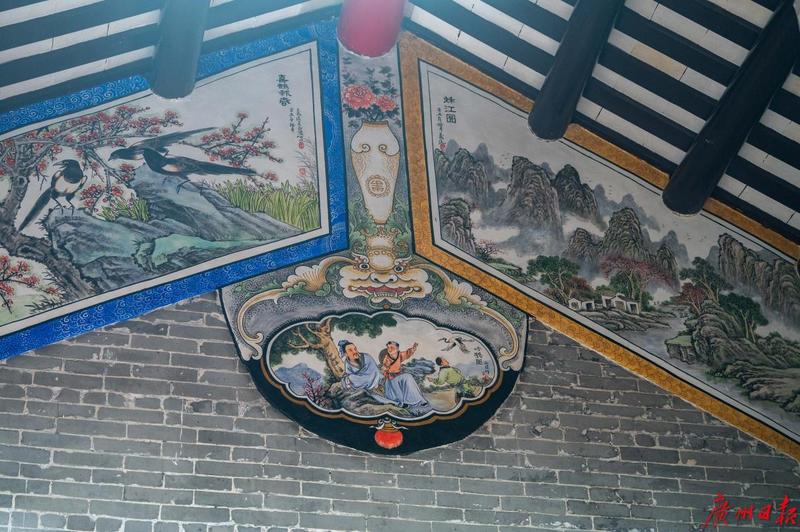
他认为,一名合格的壁画工匠应该对每一面要打交道的墙壁都了如指掌。“墙壁是会呼吸的,它最能反映气候的变化。”吴义廷解释,在进行壁画创作之前墙壁上有贝灰,空气湿度高了,贝灰将水吸进去,太阳出来了,水又会被排出来。掌握墙壁和颜料的干湿度,拿捏好时间,在限定的时间内完成作画,这很考验匠人的功底。
In Mr. He’s opinion, a qualified fresco artisan should have a thorough understanding of each wall he is about to deal with. Wu explains, “A wall can breathe and reflect best the changes in climate.” Before a fresco is drawn, shell lime has been plastered on the wall. When the ambient humidity increases, the shell lime will absorb the moisture; when the sun comes out, the moisture will be emitted from the wall. It’s a great test for an artisan’s skill foundation to master the relative humidity of wall and pigment, to have a good control over the time and to complete the painting within the time limit.
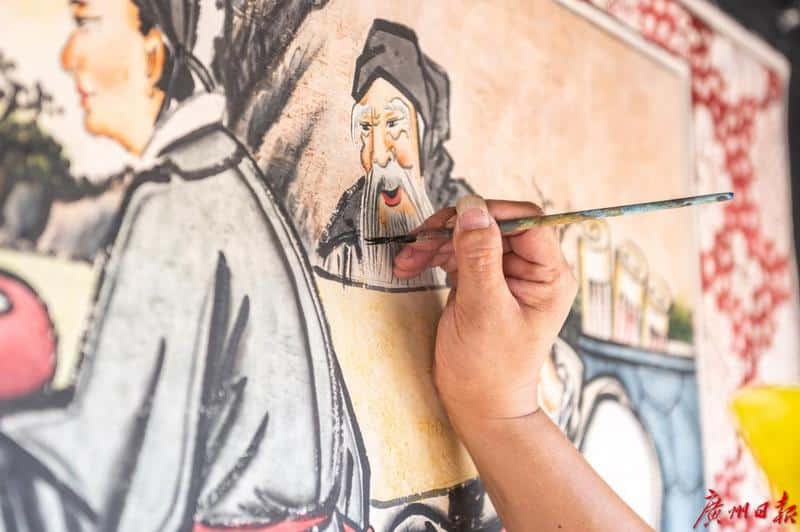
吴义廷生于壁画世家,家中几代人都是壁画匠人,他从小就痴迷画画。旧时家中的地板砖是吸水红砖,5岁的吴义廷就用毛笔蘸上清水在地砖上涂涂画画。20多岁时,他便可以独立承包壁画工程了。“回顾一步步成长,对于一名壁画匠人来说,画画的童子功最重要。”他说。
Mr. Wu was born in a fresco family, in which the families have been fresco artisans for generations. Therefore, he has been obsessed with drawing since childhood. In those old days, the floor tiles in his home were water-absorbing red bricks. The then 5-year-old Wu dipped his brush pen in pure water and painted on those floor tiles. In his 20s, the young Mr. Wu was capable of contracting fresco projects alone. He says, “When I look back on my growth path, the most important thing for me as a fresco artisan is my basic skills of painting.”
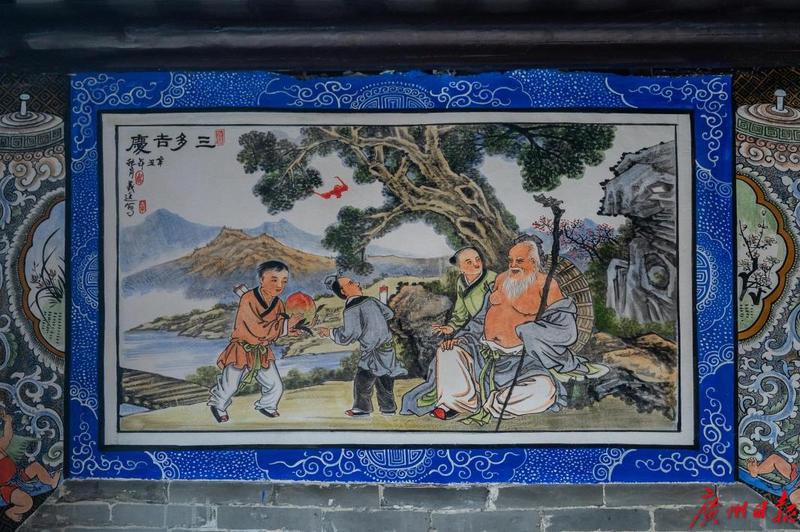
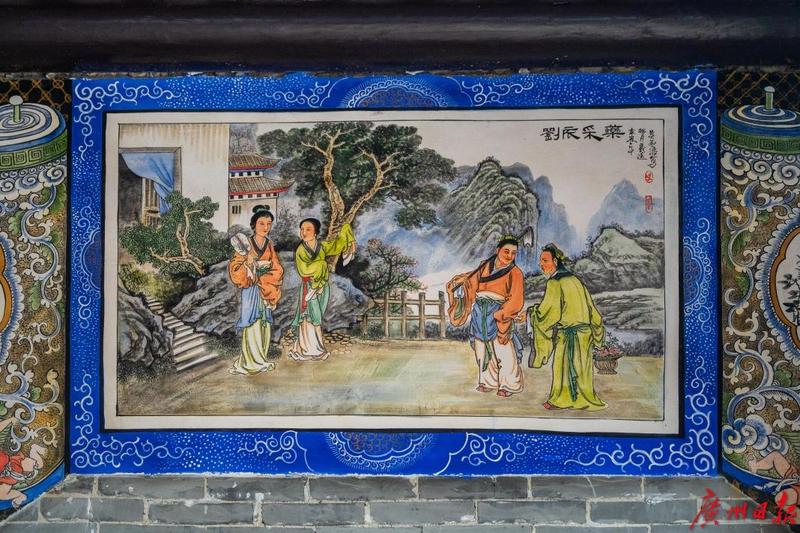

在广州鹿步大街,沿街数座祠堂正在进行修缮,这片区共8座祠堂有壁画需要修复或重绘,壁画匠人陈初敏、欧阳可朗稳稳地站在脚手架上,全神贯注地对一幅壁画作品进行修复收尾。陈初敏说,他从事壁画修复20多年了,跑过广东、广西、湖南等地,“我的手机里存了数百张各地壁画作品图片,很多是前辈名家的手笔。方便我学习技法、布局、构图,琢磨不同区域文化赋予壁画作品的不同风格。”
Several ancestral temples along Lubu Street in Guangzhou are undergoing renovation. The frescoes in a total of 8 ancestral temples require restoration or re-painting. At this moment, Chen Chumin and Ouyang Kelang, two fresco artisans, are standing firmly on the scaffold, focusing on ending a fresco restoration work. According to Mr. Chen, he has been engaged in fresco restoration for over 20 years and travelled to Guangdong, Guangxi, Hunan and other provinces. He says, “I have hundreds of pieces of frescoes in my cellphone, of which many are composed by well-know predecessors and masters. These pictures facilitate my learning techniques, layout and composition, and ruminating over the various styles of fresco works endowed by different regional cultures.
掌握墙壁和颜料的干湿度,拿捏好时间,在限定的时间内完成作画,很考验匠人的功底。吴义廷认为,壁画工匠应该对每一面要打交道的墙壁都了如指掌。“墙壁是会呼吸的,它最能反映气候的变化。”
It’s a great test for an artisan’s skill foundation to master the relative humidity of wall and pigment, to have a good control over the time and to complete the painting within the time limit. Mr. He believes that fresco artisans should have a thorough understanding of each wall he is about to deal with because “a wall can breathe and reflect best the changes in climate.”
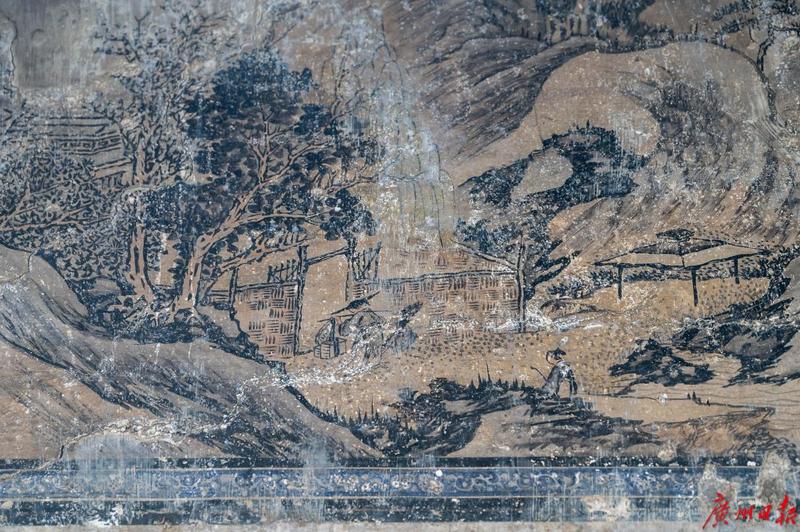
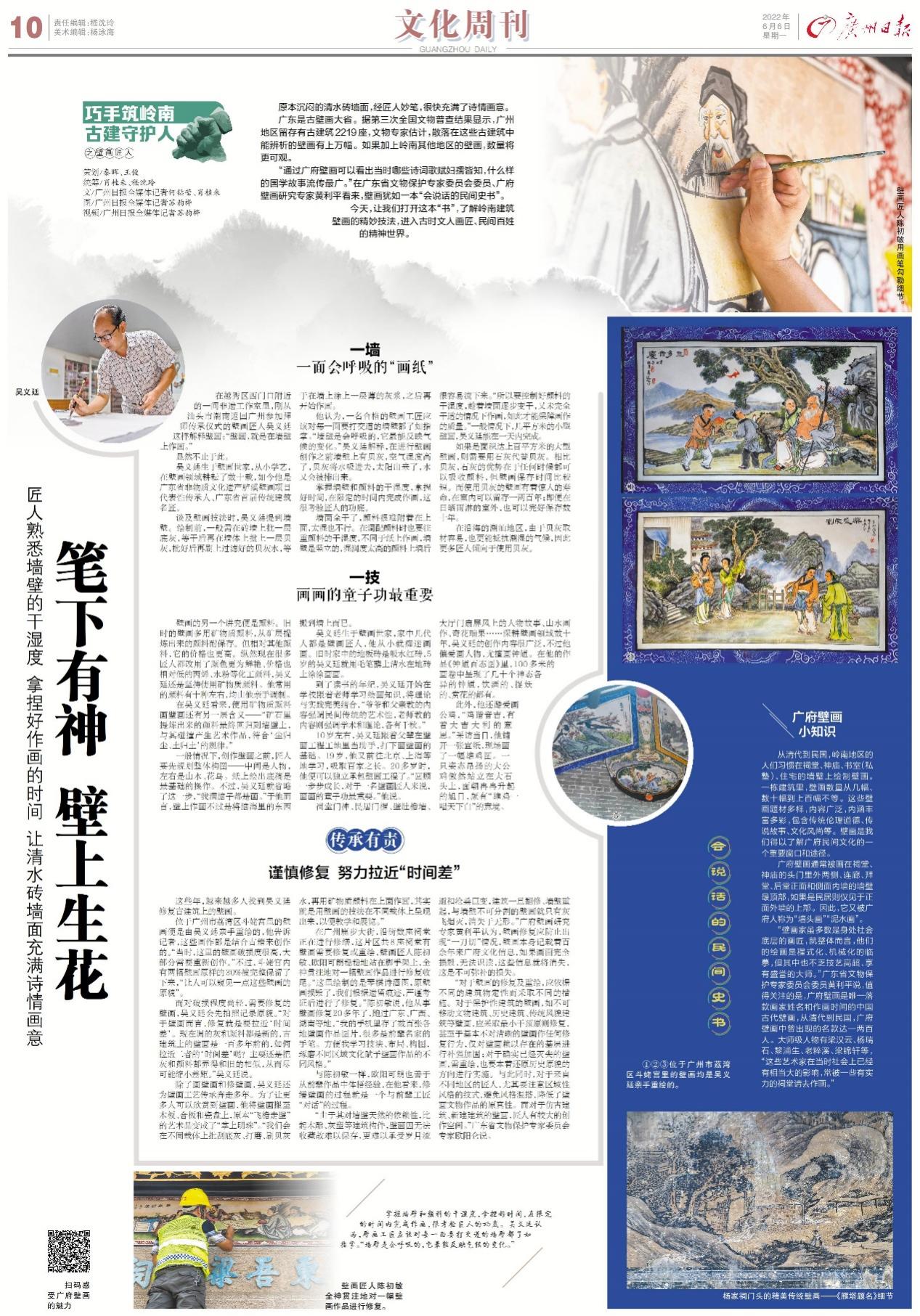
来源:广州日报
Source: Guangzhou Daily
统筹/秦晖 肖桂来
Report planning: Qin Hui and Xiao Guilai
作者:何钻莹、肖桂来、苏韵桦
Author:He Zuanying,Xiao Guilai and Su Yunhua











